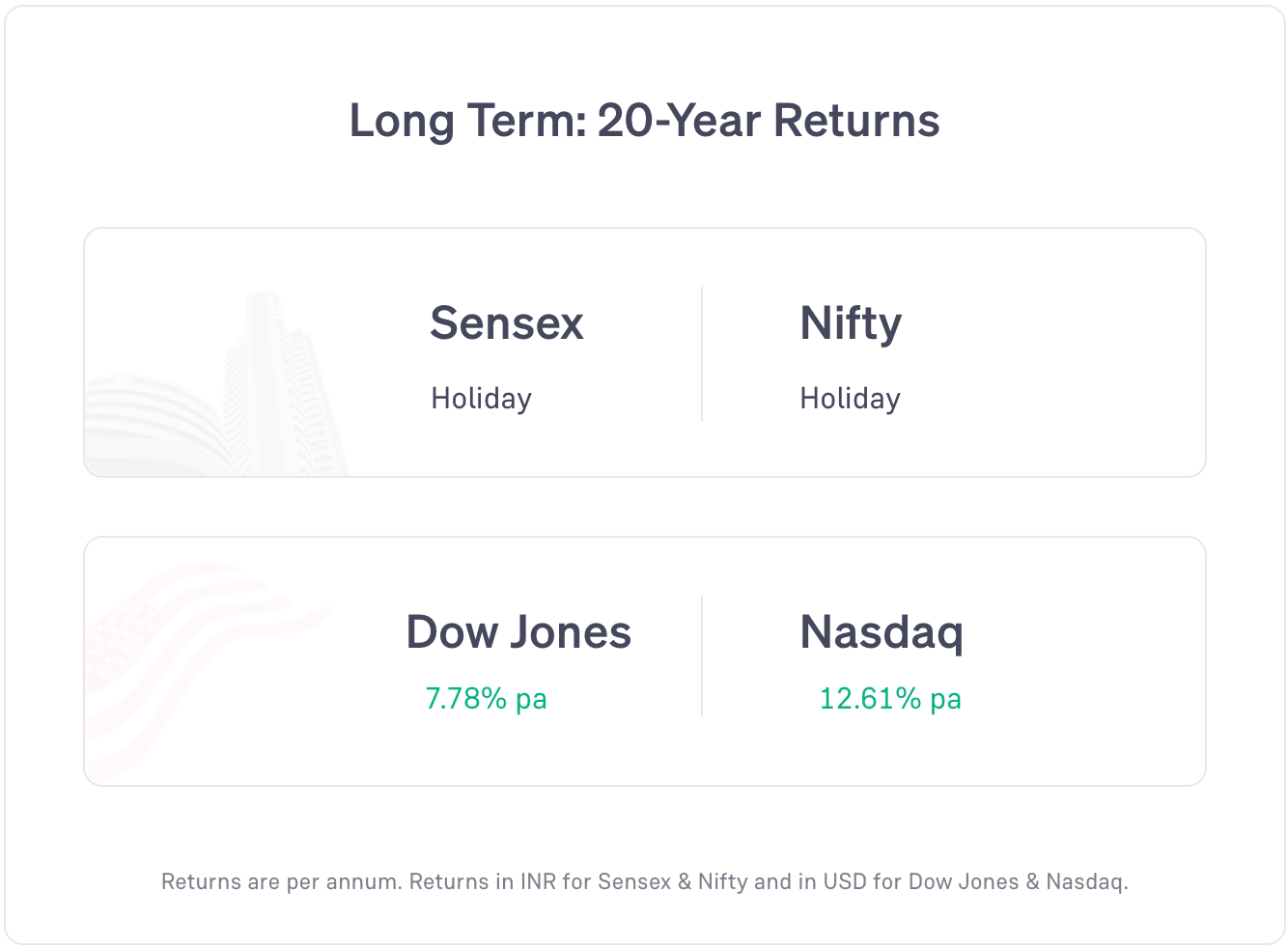Markets holiday, Grasim profits up 76%, NSE sets aside Rs 1,300 cr to settle cases with SEBI, & more - Groww Digest
Wednesday, 5 November 2025
The Indian stock markets were closed today on account of Prakash Gurpurb Sri Guru Nanak Dev.
Hence, there won’t be any updates on the Nifty 50, Sensex, Top Gainers, and Top Losers sections today.
Global markets: US markets fell. Most Asian markets and most European markets fell (as of 6 pm IST).
News
India and New Zealand are reviewing the progress of negotiations for the proposed Free Trade Agreement (FTA).
NSE has set aside around Rs 1,300 crore to settle pending regulatory cases related to co-location and dark-fibre matters with SEBI. This will also possibly help the exchange move forward with its long-awaited IPO.
Note: we will not be covering any news related to the Groww IPO till the listing date (12 Nov) due to legal/conflict-of-interest reasons#
Stocks Updates
Sun Pharma: net profit rose 3% year-on-year to Rs 3,125 crore in the July-Sept quarter.
Grasim: net profit rose 76% year-on-year to Rs 553 crore in the July-Sept quarter. The board also approved acquiring 26% stakes in 2 renewable energy SPVs with Prozeal and GMR to supply green power to its Gujarat, Andhra Pradesh, and Odisha plants.
United Spirits: announced a strategic review of its investment in Royal Challengers Sports., owner of the RCB IPL and WPL teams, to be completed by 31 March 2026.
Samvardhana Motherson: company’s Netherlands-based subsidiary ‘MGI B.V.’ and Japan’s ‘Sanko Co. Ltd.’ incorporated a joint venture company, ‘Motherson Sanko Sustainable Packaging Products EU’, in Hungary to manufacture and distribute plastic packaging products.
Adani Enterprises: incorporated a wholly owned subsidiary, Brahmani Barrage Water Ltd, to develop and operate the Brahmani Barrage water project in Rajasthan.
Adani Energy: partnered with RSWM to supply 60 MW of renewable power. It will help RSWM to meet 70% of its energy needs from green sources.
Zydus Lifesciences: received a USFDA Establishment Inspection Report for its SEZ-II Ahmedabad plant with zero observations.
Auto Updates (October)
Maruti Suzuki: sales stood at 2.21 lakh units. Domestic sales stood at 1.81 lakh units and exports stood at 31,304 units.
M&M: sales grew 26% year-on-year to 1.2 lakh units. Passenger vehicle sales grew 31% year-on-year to 71,624 units.
Tata Motors Passenger: sales grew 27% year-on-year to 61,295 units. EV sales grew 73.4% year-on-year to 9,286 units.
Hyundai Motor: sales stood at 69,894 units including export sales of 16,102 units.
Eicher Motors: sales grew 13% year-on-year to 1.25 lakh units. Exports fell 7%.
TVS Motor: sales grew 11% year-on-year to 5.44 lakh units. Three-wheeler sales grew 70% year-on-year to 18,407 units.
Ashok Leyland: sales grew 16% year-on-year to 17,820 units.
Escorts Kubota: sales grew 3.8% year-on-year to 18,798 units. Exports grew 38.4%.
Bajaj Auto: total sales grew 8% year-on-year to 5.18 lakh units.
Word of the Day
Circuit Breakers
They are temporary pauses in stock market trading that happen when prices move too sharply in a short time
They happen automatically after the sharp up/down movements.
This is done to cool down panic or overexcitement, controlling volatility in the market. They give investors time to think before trading continues.
Circuit breakers can apply to the entire market as well as individual stocks.
Example: in India, if the Nifty or Sensex falls by 10%, 15%, or 20%, trading is halted for a set period depending on how big the drop is and the time of the day.
For individual stocks, there are price bands that limit how much a stock can rise or fall in a day.
6 Day Course
Theme: credit interest cycles
Day 3: Wednesday
In practice, interest rate changes follow a cycle. One causes the need for the other.
So, when economic activity is lower, the central banks lower interest rates. This usually causes the economic activity to increase.
As economic activity increases, the spending by people goes up.
Slowly, the spending causes inflation.
Once the inflation becomes too high, the central banks raise the interest rates with the aim of controlling inflation even if that means reducing economic activity.
These changes are usually not sudden and sharp. They are done gradually.
So, the interest rates would be slowly increased when inflation starts increasing. And the interest rates would slowly start reducing as economic activity starts slowing too much.
In India, the RBI must meet at least 4 times a year to decide whether to increase, reduce, or not change the interest rates.
This meeting is called the Monetary Policy Committee (MPC) meeting.
Featured Question
“When some companies of Nifty 50 are removed from the index and some new companies are included in this index, then do the ETFs or mutual funds with Nifty 50 index also get updated automatically?”
Yes, ETFs and index funds that invest by following an index also make changes to their investing.
Their job is to mimic the index. So whenever the index changes, they have to change their holdings too.
Because ETFs and index funds have very big investment amounts, their buying/selling a stock can cause big changes in the stock price (or whichever other asset they invest in).
So, many of them start buying/selling a few days before the reshuffle takes place. They may also take some more time after the reshuffling date to complete their buying/selling.
They are able to do this because the reshuffling is usually announced a few weeks before the actual reshuffling takes place.
So everyone knows well in advance which stocks will enter and which will leave an index.
Did you like this edition?
Leave a feedback here!




Grasim's move into renewable enery SPVs is smart for long term cost structure. The green power deals with Prozeal and GMR show how industrials are locking in energy costs before the next price cycle. Similar strategies are working in US markets where energy intensive manufacturers are securing captive renewable capacity.